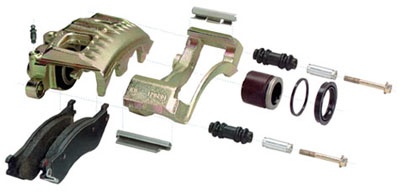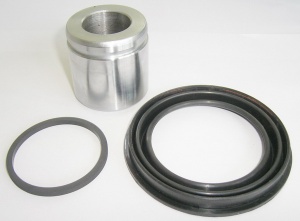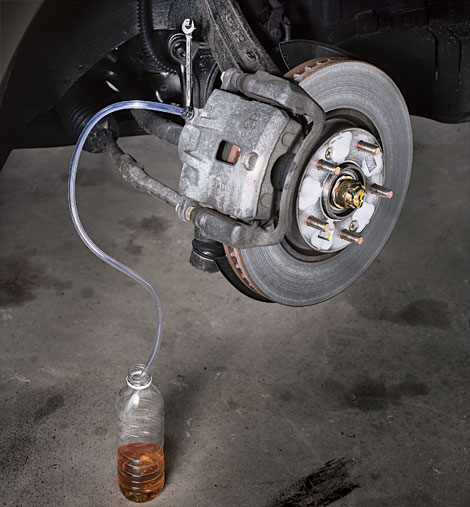- 12/08/2014
- 2 Min Read
- By: Dan Bullmore
Understanding and Maintaining Disc Brake Calipers
Since the 1970's, it's been hard to find a car that didn't have at least one set of brake calipers. Though the calipers have changed a lot over the years, the job they do has not. Caliper maintenance is a very important part of maintaining the brake system on your car, thought it is often overlooked because it isn't the most obvious thing to most car owners. Next time you have your wheels off, take a look at your brake pads and see if you notice any signs of caliper failure. Doing so can save you a lot of time and money in the long run.
Brake fluid degrades over time
Two of the most important things you can do to extend the life of your brake systems are to change the fluid regularly, and to replace your pads properly, and with good quality replacements. Many people overlook the periodic brake fluid change because it isn't as publicized as oil and transmission fluid (or even coolant) changes. Brake fluid degrades over time, and becomes contaminated with debris from the brake system. This gradual decay of the brake fluid quality can cause several issues in your brake system, from poor lubrication to rubber damage. It's important to remember that brake fluid is the only fluid in the brake system, so the calipers and pistons rely on it for smooth motion, and the ABS pump and master cylinder must remain clean and uncontaminated in order to function properly. If your brake fluid looks dark or murky, or if you don't know how recently it has been changed, a full flush and bleed is a good way to extend the life of your brake system. Be absolutely sure to use the correct DOT rating for your brake system - a higher number is not necessarily better! The DOT numbers indicate, among other things, boiling temperature and fluid composition.
Pads can crack and separate from their backing
Poor quality pads are another issue altogether. From years working in auto parts, I have seen all types of brake pads, some of which are unsafe even in their box. A keen eye and close inspection can save you from unwanted work, and more importantly, from a hazardous driving situation. Be sure that the pads you are purchasing come with all necessary mounting hardware, including clips and shims, and inspect the pads thoroughly for cracks in the friction material, and separation from the backing. Also be sure that you install the pads to the factory specification, including use of shims or grease if required. Some vehicles have pads that will fit in either side of the caliper, but which are side specific - be sure you insert these pads correctly, or you may find yourself with uneven wear patterns, or weak braking characteristics. To be sure, take notice of any differences in the shape of each pad, and compare to the old pads as you remove them from the vehicle.
Caliper rebuilds can be a DIY job
Rebuilding a brake caliper is not difficult, but is seldom done nowadays. Typically, a rebuild kit will include replacement pistons and seals. For fixed brake calipers, it may be necessary to take the caliper apart in order for the pistons to clear the housing. If you have to do this, be sure to torque the fasteners correctly. Doing otherwise can distort the piston bores, or cause small cracks to form in the caliper body. Also be sure during the rebuild to thoroughly clean the piston and bore faces, as the clearances are miniscule and highly susceptible to scoring from contamination. Also be sure that your particular vehicle does not have a specific clocking in the angle of the pistons, as is the case on my W124 Mercedes E-Class. Ensure that all seals seat properly and do not use any sharp tools in the vicinity of the seals, as tearing a seal can lead to a very hazardous situation under braking, or allow air into the brake system.
There are many methods for bleeding the brake lines on your vehicle, but bear in mind that some modern ABS vehicles have very specific brake bleeding procedures that must be followed. Not following the factory procedures can damage the ABS pump, leading to a very costly and avoidable repair. If you are not sure, call your local dealer and ask their service department about the procedure for bleeding the brakes on your vehicle.
Whenever you have the wheels off, inspect the thickness of your brake pads. If they seem low, or if one pad seems to be wearing more than the other, it may be time to look into replacing the pads or the whole caliper. Pads that wear unevenly are often a sign of binding pistons in fixed calipers, or improperly greased or seized slide pins on a sliding caliper. In either case, a rebuild or replacement of the caliper is advisable. Don't forget that you will need to bleed the brakes if you open the system for any amount of time, even if only to replace a caliper. This may be the perfect opportunity to change out that brake fluid!
As critical as the brake system is to our car, we often don't give it a second thought. Before that brake failure light comes up on your dashboard, take a second to inspect and maintain your brake system. A properly maintained brake system can save you money, if not much more.














